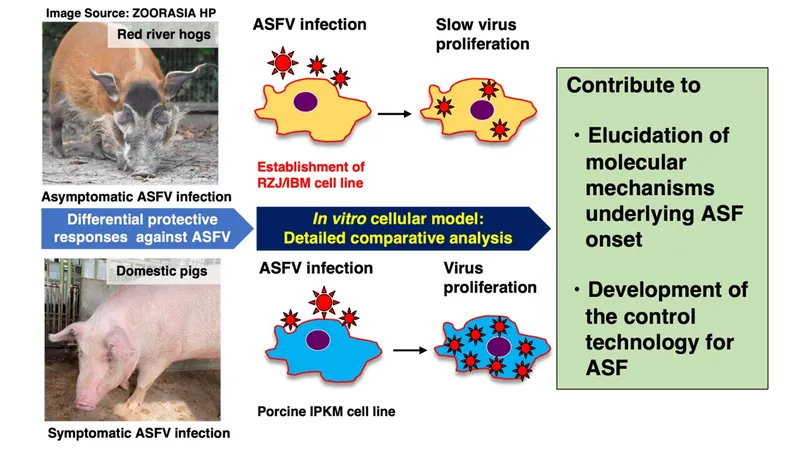
Breakthrough in African Swine Fever Virus Research: New Cell Line Discovered!
2024-11-19
Author: Rajesh
Breakthrough in African Swine Fever Virus Research: New Cell Line Discovered!
In a significant advancement for African swine fever virus (ASFV) research, a dedicated team from the National Agriculture and Food Research Organization (NARO) has successfully created an innovative immortalized cell line derived from red river hogs. These fascinating animals, native to Africa, are natural hosts of the ASFV, and the newly developed cell line promises to be instrumental in unraveling the mysteries of this deadly virus.
Understanding African Swine Fever Virus
African swine fever, a highly contagious viral disease affecting domestic pigs and wild boars, is notorious for its devastating impact on swine populations worldwide. When ASFV infects these animals, it replicates within macrophages—crucial immune cells—and typically leads to rapid fatalities characterized by severe fever and hemorrhagic symptoms. However, red river hogs handle ASFV remarkably differently, showing no symptoms whatsoever. Researchers speculate that the macrophages of RRHs possess unique protective mechanisms that enable them to combat the virus effectively without succumbing to it.
The Role of Immortalized Cell Lines in ASFV Research
Traditionally, ASFV studies have relied heavily on porcine macrophage cultures. However, the process of proliferating these cells in the lab has proven arduous and resource-intensive, requiring the use of numerous pigs to amass an adequate quantity. In a groundbreaking development, NARO had earlier introduced the immortalized porcine kidney macrophage cell line, known as IPKM, which offers an almost unlimited proliferation potential. This breakthrough has drastically improved researchers' ability to gather research materials and has accelerated the pace of ASFV investigations.
Collaboration with Yokohama Zoological Gardens
In their ongoing quest to enhance ASFV research, NARO collaborated with the Yokohama Zoological Gardens, ZOORASIA, to develop another pioneering cell line—RZJ/IBM. This was derived from surplus blood collected from a healthy male RRH during routine health checks. Observations revealed that the proliferation of ASFV within the RZJ/IBM cell cultures was significantly reduced compared to the previously established IPKM cell lines.
Future Prospects and Research Goals
Dr. Takato Takenouchi, a key figure in this research, expressed optimism about the potential for these findings. He stated, "By conducting a detailed comparative analysis of the differential responses between these two cell lines, we will edge closer to unlocking the secret behind the asymptomatic nature of ASFV-infected RRHs."
Publication and Implications for the Agricultural Community
This research has been published in the prestigious journal *Frontiers in Immunology* and holds great promise for the future of ASF prevention and vaccine development. As the agricultural community grapples with the challenges posed by ASFV, this groundbreaking work could prove vital in safeguarding pig populations globally and mitigating the threat of this harmful disease.
Conclusion
Stay tuned for more updates as researchers continue to work tirelessly in their mission to decipher the enigmatic behaviors of this virus in a bid to protect livestock around the world!



 Brasil (PT)
Brasil (PT)
 Canada (EN)
Canada (EN)
 Chile (ES)
Chile (ES)
 España (ES)
España (ES)
 France (FR)
France (FR)
 Hong Kong (EN)
Hong Kong (EN)
 Italia (IT)
Italia (IT)
 日本 (JA)
日本 (JA)
 Magyarország (HU)
Magyarország (HU)
 Norge (NO)
Norge (NO)
 Polska (PL)
Polska (PL)
 Schweiz (DE)
Schweiz (DE)
 Singapore (EN)
Singapore (EN)
 Sverige (SV)
Sverige (SV)
 Suomi (FI)
Suomi (FI)
 Türkiye (TR)
Türkiye (TR)